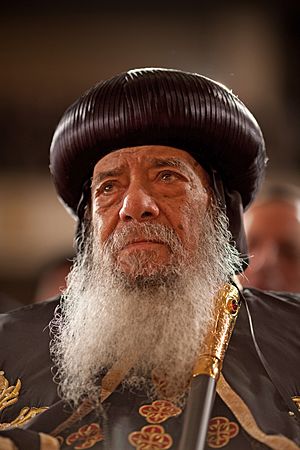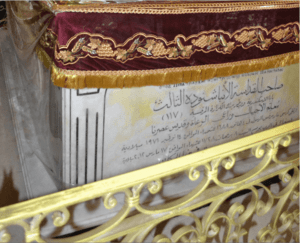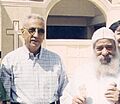Pope Shenouda III of Alexandria facts for kids
Quick facts for kids His Holiness Pope Shenouda III |
|
|---|---|
| Pope of Alexandria and Patriarch of All Africa on the Holy Apostolic Throne of St. Mark the Evangelist of the Coptic Orthodox Church of Alexandria | |

Pope Shenouda III
|
|
| Native name |
|
| Church | Coptic Orthodox Church of Alexandria |
| Archdiocese | Alexandria |
| See | Alexandria |
| Papacy began | 14 November 1971 |
| Papacy ended | 17 March 2012 |
| Predecessor | Cyril VI |
| Successor | Tawadros II |
| Orders | |
| Ordination | 1954 (priesthood) |
| Consecration | 30 September 1962 |
| Personal details | |
| Birth name | Nazir Gayed Roufail نظير جيد روفائيل |
| Born | 3 August 1923 Abnub, Asyut Governorate, Egypt |
| Died | 17 March 2012 (aged 88) Cairo, Egypt |
| Buried | Monastery of Saint Pishoy, Scetes, Egypt |
| Nationality | Egyptian |
| Denomination | Coptic Orthodox Christian |
| Residence | Coptic Orthodox Patriarchal Residence |
 |
This article contains Coptic and Arabic text. Without proper rendering support, you may see question marks, boxes, or other symbols. |
Pope Shenouda III (born Nazir Gayed Roufail) was the 117th leader of the Coptic Orthodox Church of Alexandria. He was known as the Pope of Alexandria and Patriarch of the See of St. Mark. His time as Pope lasted for over 40 years, from November 14, 1971, until his death on March 17, 2012.
Pope Shenouda III was a very important figure in his church. He was also respected by people of other faiths, including Muslims. He worked hard to bring different Christian groups closer together. He taught about peace, understanding, and forgiveness through his writings and speeches. Many people called him the 'Teacher of Generations'. This was because he could explain difficult religious ideas in a simple way.
Contents
Early Life and Education
| Papal styles of Pope Shenouda III |
|
|---|---|
 |
|
| Reference style | His Most Blessed Beatitude and His Holiness |
| Spoken style | Your Holiness |
| Religious style | Pope and Patriarch |
| Posthumous style | The Thrice Blessed Pope |
Nazir Gayed Roufail was born on August 3, 1923, in a village called Salaam in Egypt. He was the youngest of eight children. His mother passed away when he was very young. His older brother, Raphael, raised him.
Nazir went to school in different parts of Egypt. He started writing poetry at age 14. He was very active in the Coptic Sunday School movement by age 16. He taught Sunday School classes in Cairo.
In 1943, Nazir started studying English and History at Cairo University. During his summer breaks, he often visited the Syrian Monastery in the desert. In 1946, he also began taking evening classes at the Coptic Theological Seminary. He was allowed to join even though he was still in university.
After graduating from Cairo University in 1947, he worked as a high school teacher. He taught English, History, and Social Sciences. At the same time, he continued his studies in archaeology and ancient history. In 1949, he became a teacher at the Coptic Theological Seminary. He also became the editor of the Sunday School Monthly Magazine. In 1950, he decided to work full-time at the Seminary.
Becoming a Monk
On July 18, 1954, Nazir joined the Syrian Monastery. He became a monk and was given the name Father Antonios el-Syriani. From 1956 to 1962, he lived alone in a cave near the monastery. He spent his time praying and meditating. He was known for his very strict and simple way of life. In 1958, he became a priest.
Serving the Church as a Bishop
On September 30, 1962, Pope Cyril VI appointed Father Antonios as a bishop. He was put in charge of Christian Education and became the head of the Coptic Orthodox Theological Seminary. At this time, he took the name Shenouda. This name honored a famous Coptic saint, Shenoute the Archimandrite. Two previous popes had also used this name.
Under Bishop Shenouda's leadership, the number of students at the Seminary grew three times larger. He believed that bishops and priests should be chosen by the people. This idea caused some disagreements, and he was briefly suspended in 1966. However, these issues were later resolved.
Becoming Pope: A New Era
After Pope Cyril VI passed away in 1971, Bishop Shenouda was chosen to be the new Pope. He became Pope Shenouda III on November 14, 1971. He was the 117th Pope of Alexandria. His enthronement ceremony was held in the new Saint Mark's Coptic Orthodox Cathedral in Cairo.
Expanding the Church Worldwide
During his time as Pope, the Coptic Church grew a lot, especially outside Egypt. He appointed the first bishops for North America. In 1971, there were only four Coptic churches in North America. By the time he passed away, there were over 250 churches there. He also appointed the first Coptic bishops in Europe, Australia, and South America.
Pope Shenouda III was very committed to bringing different Christian churches together. He was the first Coptic Pope in over 1500 years to meet with the Pope of Rome. This happened in 1973. They signed an agreement about the nature of Christ, which was a step towards Christian unity.
Challenges and Leadership
Pope Shenouda III faced many challenges during his time as Pope. He worked hard to protect the rights and welfare of Coptic Christians in Egypt.
Standing Up for His People
In 1981, Pope Shenouda III had disagreements with the Egyptian President, Anwar Sadat. The President had made some decisions that worried the Christian community. These included encouraging certain Islamic groups and making changes to the constitution that seemed to favor Islamic law. There was also an increase in violence against Christians.
Pope Shenouda believed that the government was not doing enough to protect Christians. He also felt that the President's peace treaty with Israel was not the right step at that time. Because of these disagreements, President Sadat removed Pope Shenouda from his position and sent him to a desert monastery. However, Coptic Christians still saw him as their true leader. He continued his duties from the monastery.
President Sadat was assassinated a month later. In 1985, Pope Shenouda III was fully brought back to his role by the new President, Hosni Mubarak.
Relations with Other Churches
Pope Shenouda III was known for his strong belief in ecumenism, which means working towards unity among different Christian churches. In 1973, he became the first Coptic Orthodox Pope to meet the Bishop of Rome in over 1500 years. They signed a joint statement about Christology, which is the study of Jesus Christ. This was a big step towards Christian unity. He also had discussions with many Protestant churches around the world.
He once said, "The whole Christian world is anxious to see the church unite. Christian people, being fed up with divisions, are pushing their church leaders to do something about church unity and I am sure that the Holy Spirit is inspiring us."
Pope Shenouda also faced a challenge with the Ethiopian Church. After the Ethiopian Patriarch was imprisoned in 1974, Pope Shenouda refused to recognize the new Patriarch chosen by the government. He believed this was against church law. This caused formal ties between the two churches to be cut for many years, though they remained in full spiritual connection. Relations officially resumed in 2007.
His Passing and Legacy
Pope Shenouda III had been ill for some time, suffering from kidney disease and diabetes. He passed away on March 17, 2012, at his home in Cairo. He was 88 years old.
His funeral was held three days later, on March 20. He was buried at the Monastery of Saint Pishoy in Egypt, as he had wished. Before his burial, his body was placed on a ceremonial throne at St. Mark's Cathedral. It is estimated that over a million mourners came to pay their respects.
Reactions to His Death
His death brought many reactions from Egypt and around the world. The Egyptian government declared three days of mourning for Christians. Many political and religious leaders expressed their sadness. The Grand Imam of Al-Azhar University, Sheikh Ahmed el-Tayeb, said that Egypt had lost "one of its rare men."
Internationally, leaders also shared their condolences. Pope Benedict XVI of the Roman Catholic Church remembered Pope Shenouda's efforts for Christian unity. U.S. President Barack Obama called him "a beloved leader of Egypt's Coptic Christians and an advocate for tolerance and religious dialogue." Many other countries, including Iran, Armenia, and the United Kingdom, also sent messages of sympathy.
Achievements and Recognition
Pope Shenouda III was a respected leader who received many honors for his work.
Awards and Honors
In 2000, he received the UNESCO-Madanjeet Singh Prize for promoting tolerance and non-violence. UNESCO recognized him for encouraging understanding between Christianity and Islam. They also praised his efforts to build connections with other Christian groups. In 2003, he received the Al-Gaddafi International Prize for Human Rights.
Honorary Degrees
He received honorary degrees from several universities around the world, including:
- University of Bonn
- North Park University
- University of Toledo
- University of Michigan
- Eötvös Loránd University
- Saint Peter's University
- Saint Vincent College
- Bloomfield College
Special Honors
He also received high honors from various countries and churches:
| Ribbon bar | Country | Honour |
|---|---|---|
| Egypt | Grand Collar of the Order of the Nile | |
| Egypt | Grand Cordon of the Order of the Arab Republic of Egypt | |
| Egypt | Grand Cross of the Order of Merit (Egypt) | |
| Ethiopia | Grand Cross of the Order of the Star of Ethiopia | |
| Ethiopia | Grand Cordon of the Order of Solomon | |
| Sudan | Grand Cordon of the National Order of El-Nilein | |
| Syriac Catholic Church | Grand Cross of the Order of Saint Ignatius of Antioch |
Images for kids
-
The funeral of Pope Shenouda III was attended by religious figures in the Arab world. Shown in this image are, from the left, Moez Masoud and Habib Ali al-Jifri.
See also
 In Spanish: Shenouda III para niños
In Spanish: Shenouda III para niños
- List of Copts
- List of Egyptians







